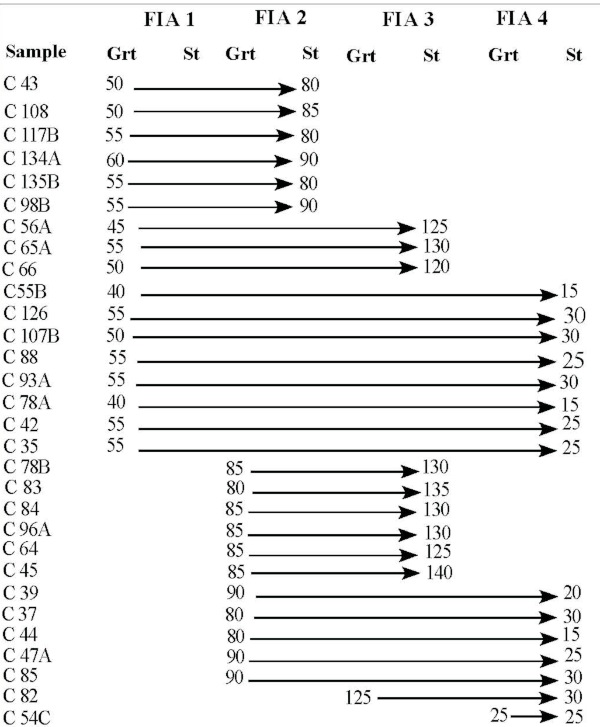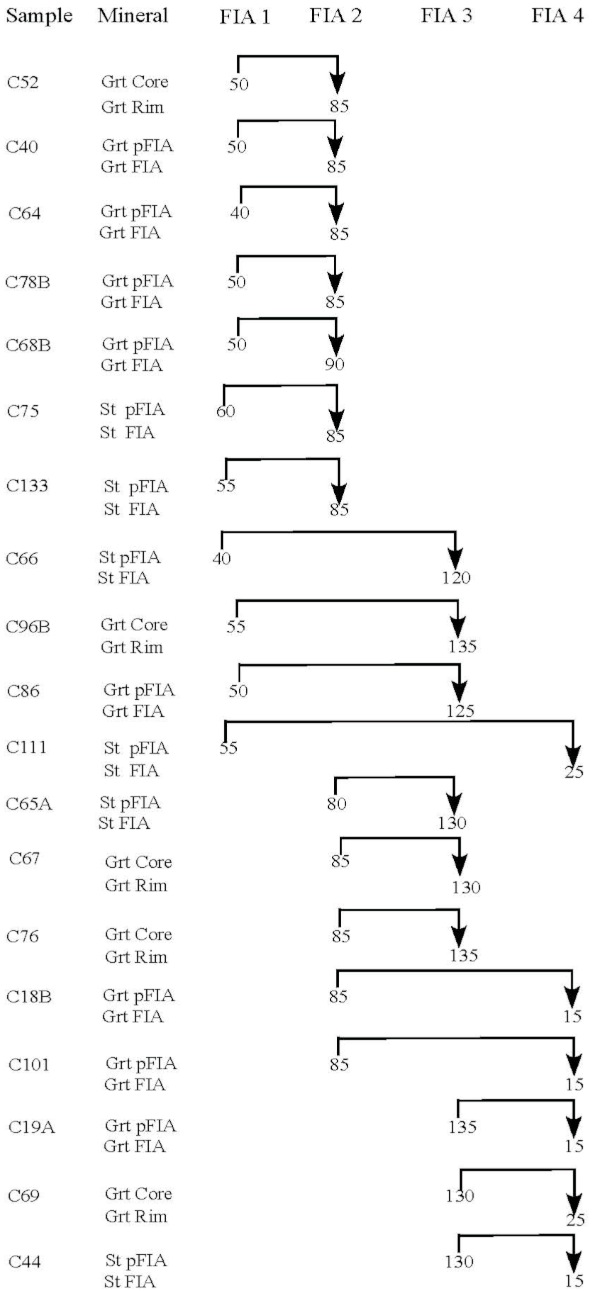FIA results
A total of 67 oriented samples were collected that contained inclusion trails well enough developed (Figs. 7 and 8) for FIA measurement. 800 oriented thin sections were prepared from these samples. A total of 138 FIA and pseudo-FIA trends were measured (Table 2) and are shown as trends on a map for each sample location in Fig. 11 and as a rose diagram in Fig. 12a. The combined FIA trend data for garnet and staurolite is shown in Fig. 12b. A total of 64 and 53 FIAs were measured in garnet and staurolite porphyroblasts respectively (Fig. 11). Samples C52, C67, C69, C76 and C98B preserve a different FIA in the core versus the rim in garnet (Fig. 12a, b and c). The other porphyroblastic phases in which FIAs were measured were cordierite and andalusite, with 14 obtained from the former and 7 from the latter. Their trends are given in Table 2, shown in map view in Fig. 11, and on a rose diagram in Fig. 12. Many samples preserve differentiated crenulation cleavages that have been overgrown by the porphyroblasts where the asymmetry of the crenulated cleavage can be determined (Figs. 8, 9 and 13d, e). The crenulated cleavages consist of quartz and ilmenite grains, while the remains of differentiated crenulations cleavages predominantly contain ilmenite grains. The intersection between the crenulated and crenulation cleavages can be determined, when viewed in three dimensions, and is called a pseudo-FIA (p-FIA) as it predates porphyroblast growth. The actual FIA is formed during porphyroblast growth and in these samples is defined by the curvature of the differentiated crenulation cleavage (Table 4 and Figs. 8 and 9).
Figure Table 3. Relative succession of FIAs measured in samples where both garnet and staurolite porphyroblast occur in a single sample (units are in degrees)
Figure Table 4. Relative succession of FIAs, within garnet and staurolite porphyroblast, using core/rim and pseudo-FIA criteria (read text for details)
Figure 11. FIA trends for successive FIA sets in Big Thompson region of Colorado Rockies

FIA trends for successive FIA sets in Big Thompson region of Colorado Rockies. (a) Shows the geological map, location and the FIA trends of all samples which preserve inclusion trails of (a) FIA set 1, (b) FIA set 2, (c) FIA set 3 and (d) FIA set 4. FIA set 1 and 2 are preserved only within garnet and staurolite porphyroblast, while as FIA set 3 and 4 are contained within andalusite and cordierite porphyroblast as well.
Figure 12. Equal area rose plot of all FIA trends measured within samples

(a) equal area rose plot of all FIA trends measured from garnet, staurolite, andalusite and cordierite. Four peaks occur at 25º, 55º, 85º and 135º. (b) garnet FIAs (c) staurolite FIAs, (d) garnet plus staurolite FIAs, (e) andalusite FIAs, (f) cordierite FIAs.
Figure 13. Equal area rose plot of all samples preserving multiple FIA trends

(a) Equal area rose plot of FIAs in all samples preserving changes in trend from core to rim in garnet porphyroblasts. (b) core FIAs. (c) rim FIAs. (d) pseudo-FIAs in garnet. (e) pseudo-FIAs in staurolite.

